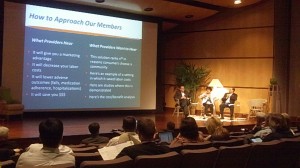CEDIA presents: Home Health Technology And You…In 60 mins or less…led by GrandCare
Home Health Technology and You…in 60 minutes or less
 July 26, 2011 at 3:00 p.m. EDT
July 26, 2011 at 3:00 p.m. EDT
Presented by Laura Mitchell, VP Marketing for GrandCare Systems
The statistics are in – the aging population is growing faster than ever and service providers and family caregivers are turning to technology as a solution. Find out why this industry is growing so fast, why dealers/integrators are a necessary component and 10 steps to quickly get started! 
Laura Mitchell, VP Marketing, GrandCare Systems
 Laura is a founding member of GrandCare Systems, a software technology that combines aspects of Home Automation, Social Networking, Video Chat, Entertainment, Activity of Daily Living monitoring and Tele-health assessment into one flexible and easy-to-use system. A significant part of her role was to bring the product to market through the development of a nation-wide distributor/dealer network while getting the GrandCare brand known throughout the industry. Laura specializes in Social Media and non-traditional guerilla marketing. Laura was a 2011 recipient of the Flame Award for Excellence in Leadership and Innovation from the What’s Next 2011 Boomer Business Innovation Awards.
Laura is a founding member of GrandCare Systems, a software technology that combines aspects of Home Automation, Social Networking, Video Chat, Entertainment, Activity of Daily Living monitoring and Tele-health assessment into one flexible and easy-to-use system. A significant part of her role was to bring the product to market through the development of a nation-wide distributor/dealer network while getting the GrandCare brand known throughout the industry. Laura specializes in Social Media and non-traditional guerilla marketing. Laura was a 2011 recipient of the Flame Award for Excellence in Leadership and Innovation from the What’s Next 2011 Boomer Business Innovation Awards.
Laura speaks throughout the country on Social Media, Go-to-market Strategies and Enabling Technologies in the Aging Industry.
She is a founding member and serves as a Director on the AgeTek Alliance board (www.agetek.org), is a key organizer for the EHX and CEDIA Home Health Pavilions and Educational Tracks, and is the creator/host of the bi-weekly, industry-wide GrandCare Aging and Technology webinars.
Laura is a graduate of the University of Wisconsin in Madison and lives in Wisconsin with her husband and her two little boys.
For more information on this webinar, visit: http://www.cedia.net/education/elearning_webinar.php








